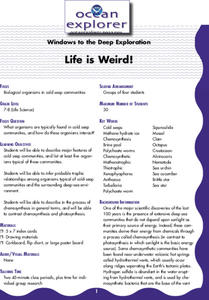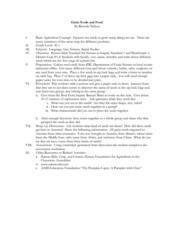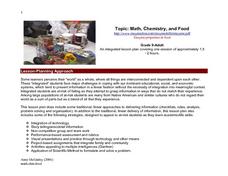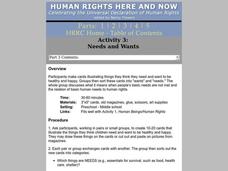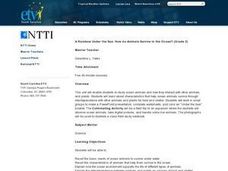Curated OER
Tzedakah: How Can We Help?
Young scholars define what constitutes a nutritious meal, the price of a healthy meal, and understand that some people can't afford healthy meals. In this healthy meals lesson plan, students estimate and research the cost of a nutritious...
Curated OER
Tzedakah: How Can We Help?
Students identify nutritious meals and the prices of a healthy meal. In this nutritious meals lesson, students work in small groups and plan a menu for a nutritious meal. Students figure the total cost of the meal and collect money to...
Curated OER
Obesity, Eating Habits and Weight Loss
Students conduct Internet research, view film and participate in class discussion to identify the problem and causes of obesity in America. They evaluate the food pyramid and break down the nutritional components of fast food and frozen...
Curated OER
A Balanced Diet
Students determine which healthy foods comprise a well balanced meal. Using a checklist, students classify foods as healthy or unhealthy. This lesson plan is intended for students acquiring English.
Curated OER
Starvation in the Ghettos
Students investigate how human beings survive under camp and ghetto life's extreme condition while understanding the USRDA requirements. They recognize the suffering and loss of life due to the lack of adequate nutrition.
Curated OER
Hunters and Gatherers
Sixth graders participate in mapping and other activities to understand why ancient civilizations developed as they did. In this ancient civilization instructional activity, 6th graders recognize that there were three important climate...
Curated OER
Protein Puzzles
High schoolers examine the concept of protein structure. They read an article, construct a three-dimensional model of an insulin protein, take a quiz, conduct Internet research, and answer discussion questions.
Curated OER
The Brown Rice Bonus
Students investigate how brown rice can be incorporated into a daily healthy diet. They practice preparing and storing the rice in the most beneficial ways. Also goals are set to increase the consumption of it in the dose of twice a week.
Curated OER
Life is Weird!
Students describe major features of cold seep communities, and list at least five organisms typical of these communities. They infer probable trophic relationships among organisms typical of cold-seep communities and the surrounding...
Curated OER
The Ancient Mediterranean: Trade, Contact, and Cultural Diffusion
Ninth graders begin the lesson plan by being introduced to the basic terms of economics. In groups, they discover how they are affected by trade because of the clothes they wear and foods they eat. Using primary sources, they examine...
Curated OER
What are Hunger and Malnutrition and Who are the Hungry?: Food, Ethics, Global Cultures
High schoolers explain the consequences of hunger and malnutrition, to know the magnitude of hunger in the world today and to know who is hungry and malnourished in the world.
Curated OER
Farming in a Fishbowl: How Ethnic Groups in
Seventh graders research Chinese agricultural needs and practices. They conduct an experiment with aquaculture and germinated rice as they take measurements and apply the scientific method.
Curated OER
Grain Seeds and Food
Students observe the characteristics of different seed types. They classify, sort, name and write about the seeds.
Curated OER
Topic: Math, Chemistry, and Food
Learners listen as the teacher tells the story of Sisyphus rolling the stone up the mountain. Students prepare two batches of jello, one with fresh pineapple, and one with canned pineapple. While the jello is setting, learners work on...
Curated OER
Fractions in Shapes
First graders explore fractions with manipulatives. In this fraction lesson, 1st graders use paper foods such as sandwiches and pizza in order to find halves, thirds, fourths, eighths, and more. This lesson is divided up into 3 tiers...
Curated OER
Outdoor Survival
Students are introduced to basic outdoor survival concepts. They identify the seven basic needs for survival. Students describe the symptoms and treatment for frostbite and hypothermia. They compare and contrast the value of different...
Curated OER
Investigation Xylem
Students investigate how water travels up the stem of vascular plants by using food coloring to stain the xylem of a number of different plants. They know the function of leaves, stems, and root at the end of the experiment.
Curated OER
Hunters/Gatherers
Young scholars discuss the ways in which an environment is used to provide the basic necessities of life. In groups, they compare and contrast how different hunter and gatherer groups have used the environment to their advantage. They...
Curated OER
Introduction To Insect & Spider Body Parts
Students inspect several different specimens of insects and spiders to determine characteristics that are similar and different between the two groups. They identify the basic body structure of spiders and insects and then predict where...
Curated OER
Algae Experiments
Students describe the characteristics of algae. In this biology instructional activity, students perform a series of experiment to explore algae. They investigate the basic things algae need to survive.
Curated OER
Make Waves
Sixth graders discover, through exploration, the basic characteristics of waves. After a lecture/demo, 6th graders work in groups and participate in a series of labs where they investigate waves. Each group presents its findings to the...
Curated OER
Needs And Wants
Students make cards illustrating things they think they need and want to be healthy and happy. Groups then sort these cards into "wants" and "needs." The whole class discusses what it means when people's basic needs are not met and the...
Curated OER
A Rainbow Under the Sea: How do Animals Survive in the Ocean?
Second graders read books, watch videos, complete worksheets and participate in class discussions about ocean animals. They, in groups, design PowerPoint presentations on selected marine animals.
Curated OER
Creature Features
Pupils examine why certain animals live in only specific places throughout the world. Using animals, they classify them based on their characteristics and identify their basic needs. They also observe and compare the life cycles of...
Other popular searches
- Five Basic Food Groups
- Four Basic Food Groups
- 4 Basic Food Groups
- 5 Basic Food Groups
- Basic Food Groups Free
- 3 Basic Food Groups
- Basic Food Groups Worksheets








